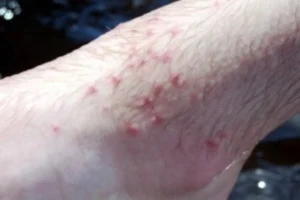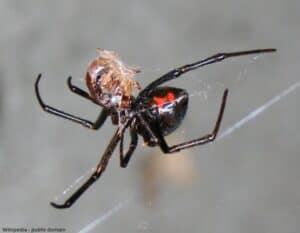Overview of Lawn Pest Insect Problems
While insects are not an overwhelming problem in lawns and sports fields in California, the can become damaging pests that kill large areas of turf. The damage caused by pest insects is often mistaken for dog or other animal urine and first appears as small yellow, brown, or dead spots. If not diagnosed correctly, these areas can quickly spread to cover large area of grass.
Insects that inhabit the surface and subsoils of lawns and turfs bring larger pest animals that damage the beauty of greenways as they dig for food.
The most common insects that cause damage to lawns in California are white grubs, cutworms and armyworms, sod web worms, and billbugs. These insects feed on different parts of the plant including the roots, crowns, and leaves.
Here is a really good five minute video from a lawn production specialist covering a large variety of lawn and turf pests, including ones mentioned below that occur in California.
Below is a brief description of each insect, the damage they cause, and how to monitor and determine if they may be causing a problem on your grass.
Related Lawn Care Topics
- Using Wetting Agents to Reduce Water Bills
- Plant Growth Regulators in Lawn Care
- Lawn Care and Negative Impact of Overwatering
- Understanding Fertilizers
White Grubs – Identification, Monitor and Treat
White grubs are the most common pest in California lawns and are capable of causing significant damage. They are the larval stage of masked chafers, “May Beetles”, “June Bugs” which are a common site in the summer months. These grubs are around 1 inch long, have 6 legs, are whitish to yellow in color with a reddish head, and are C-shaped.
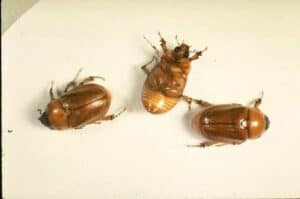
Grub damage usually occurs in early and late summer. The damaged is caused when grubs feed on the roots. This causes the grass to appear wilted and dry. If you can easily peal or pull out large chunks of turf with some soil attached, this is a good indirect identification of a white grub problem.
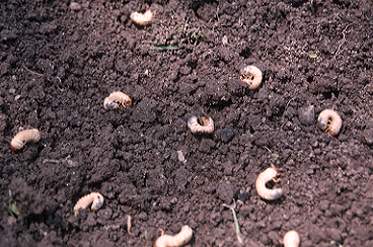
To monitor and determine if you have a significant problem, dig out a 1 foot square section of lawn to get a direct identification of a white grub problem.
If there are more than 8 white grubs you have a problem that should be addressed. As you will find white grubs generally in this environment, so as not to over-treat your lawn or turf, it is advised to set this type of white grub “pest tolerance level” before treating. Chemical treatments are the best option.
Cutworms and Armyworms – Identification, Monitor and Treat
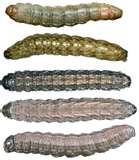
Cutworms and Armyworms are fat and range in color from green, dark gray, to brown. The larvae can be up to 2 inches long. When disturbed, they will curl up and lie still. Adult cutworms and armyworms appear as brown moths, 1-1 ½ inches long, in the spring and summer.
While cutworms are usually solitary feeders, armyworms feed in groups. However, the damage done is very similar and occurs from March through October. Cutworms and armyworms burrow in their holes during the day and come out to feed during the night. They feed on the crowns and leaves of the plant and show damage as small circular depressed spots. These spots are much more noticeable in grass that is mowed shorter. Just because you don´t see the damage in taller grass, still they are doing significant damage.
A good way to monitor for these pests is to use a light to inspect just before dawn for moths that are around 1 inch in size flying around. You can also use a drench test which is described below under the sod webworm heading.
Sodworms – Identification, Monitor and Treat
Sod webworms are creamy in color and have a distinctive double row of black or brown spots down the back.
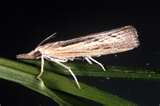
The adult sod webworm takes the form of a white or light brown moth ¾ or less in size and when at rest is very slender.
Sod webworms do damage to turf by cutting off or notching leaf blades and pulling them into their burrow to eat. Areas of heavy sodworm infestation may quickly develop irregular areas of brown patches.
Monitor for webworms from June to October by drench testing. To perform a drench test remove the top and bottom from a 6 inch coffee can. Place the coffee can at the edge of an area you suspect to be sodworm infested. Twist or push the can 2 to 3 inches into the ground. Then continually fill it with water for 10 minutes. If more then 7 worms float to the top your lawn should be treated. As you will find sodworms generally in this environment, so as not to over-treat your lawn or turf, it is advised to set this type of sodworm “pest tolerance level” before treating.
Billbugs – Identification, Monitor and Treat
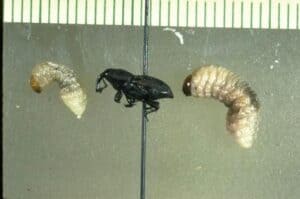
In the larval stage billbugs are 3/8 of an inch long, creamy white with a brown head, and legless. Adult billbugs are beetles that are 1/3 of an inch long and have a snout.
Larvae first do damage by feeding on the inside of the stems and crowns of grass. As they grow they move into the soil to feed on shallow roots. The damage to the grass looks similar to white grub damage. The difference being that billbugs feed higher up on the roots. Therefore, when you peel the grass, you will find that soil will not be attached.
To monitor for billbugs you can dig up the soil and look for grubs. You can also pull grass in the affected area and if the stalks break easily you will see sawdust like material which is the excrement of the billbugs. Remember, billbug larva do not have legs. You can also perform a drench test. It will help to add an ounce or so of dishwashing soap to the water.
Hearts Pest Management Lawn and Turf Care Pest Professionals
Our lawn care and turf pest professionals are here to help you with the identification, monitoring and treatment of white grubs, cutworms, armyworms, sodworms, pillbugs, simply any lawn and turf pest issue. Call us for help improving your greenscapes.
For more information on landscape pests and treatment please visit our page on Lawn and Yard Pest Control

